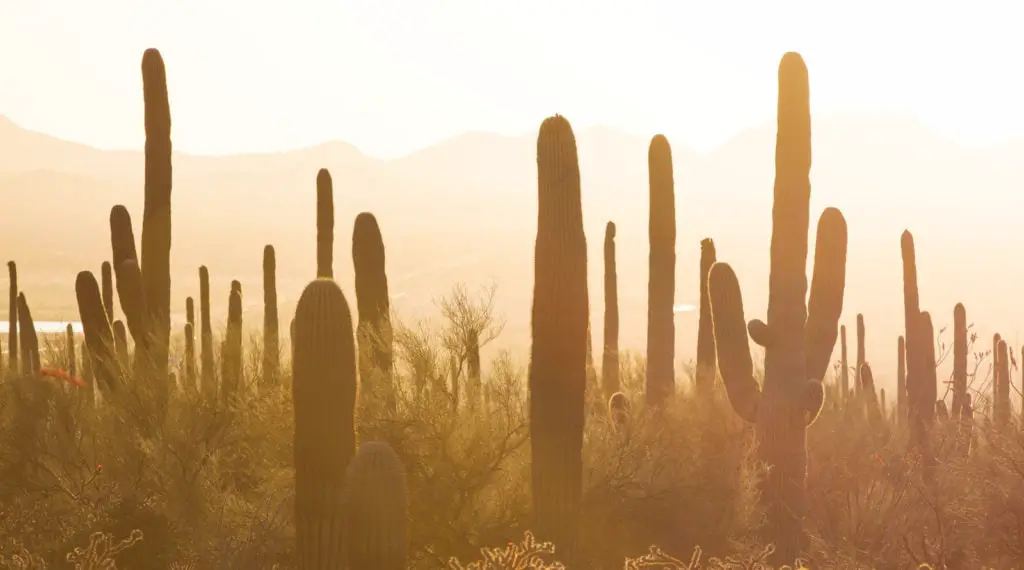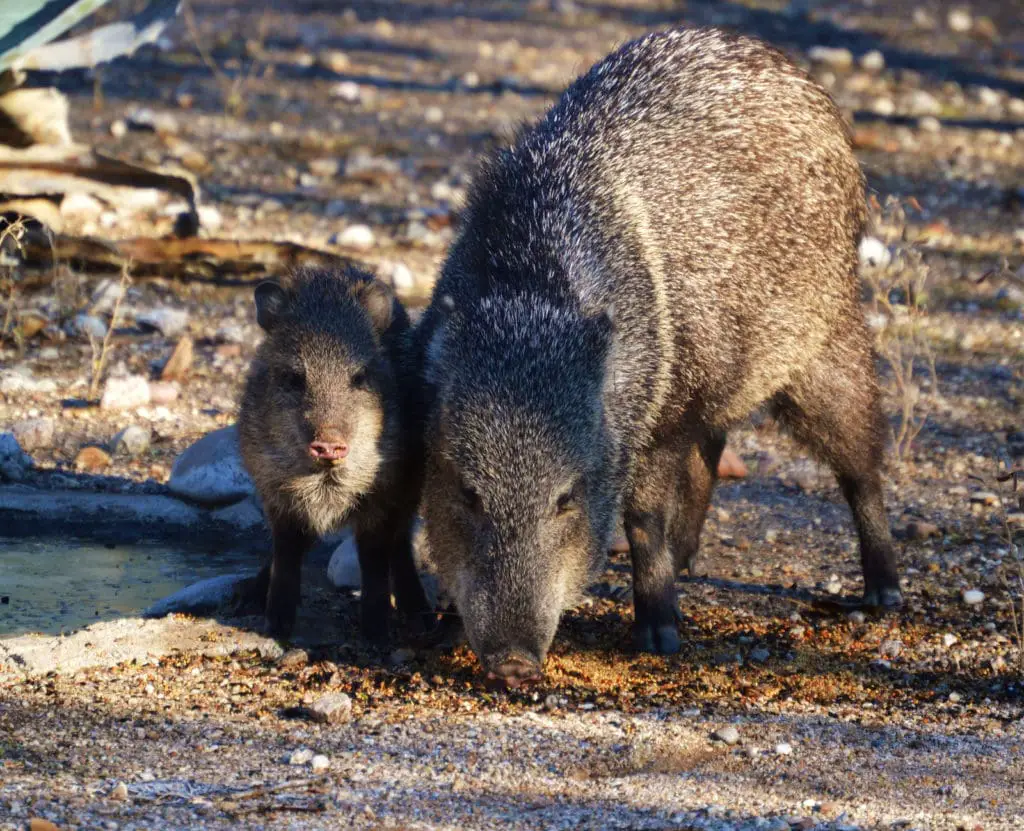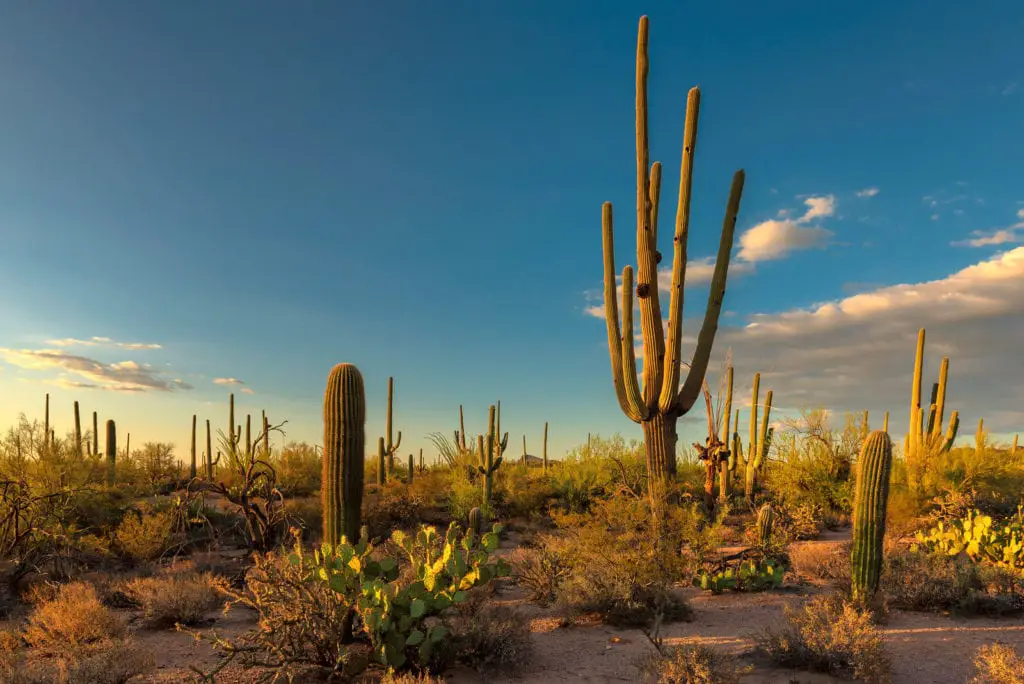If you’ve ever been to Arizona, you’ve probably seen a cactus…or ten. In Arizona’s southeastern corner is Saguaro National Park, a park known for its cacti. Not just any cacti though. It’s the most unique looking cacti there is and resembles(to me), huge humans littered in the desert with their arms in the air, known as a saguaro. This large park attracts over 700,000 visitors each year due to its amazing saguaro cacti and proximity to Tucson. Saguaro National Park encompasses two different areas: the Tucson Mountain District and the Rincon Mountain District. These areas offer visitors diversity in plant life, wildlife, and landscape.

Saguaro National Park should definitely be on your list of national parks to visit, especially if you’re already in Arizona or Tucson! Keep reading and we’ll tell you everything you need to know about visiting Saguaro National Park.
We’ll touch on:
- What the park is known for
- Top spots to see
- Hiking information & trail recommendations
- Camping information
- Where to stay when you visit
1. What is Saguaro National Park known for?
The answer to this question probably seems pretty straightforward…Saguaro National Park is known for its saguaro cactus. The saguaro cactus can only be found in this part of the ENTIRE world. More than that, however, the Saguaro National Park gives visitors a look into one of the United States’ most interesting environments: the Sonoran Desert.
You can visit the park in a multitude of ways, through hiking, vehicle, horseback, and more. It is both family-friendly and accessible in parts, while more remote in others. The park is also home to a vast array of different rocks, offering us a look into geology and geological history. Its oldest rocks, the Pinal Schist, are believed to be around 1.7 billion years old.
The Saguaro Cactus
The park’s main attraction, the saguaro cactus, is definitely something you’ll want to see at least once in your lifetime. The saguaro cactus is a cactus species resembling a tree that is native to the Sonoran Desert. While in the park you can expect to see the land littered with these special cacti, it’s a very special place. Its blossom is Arizona’s state wildflower. The cactus itself is so impressive because of its sheer size. Saguaro cacti can grow to be over 40 feet tall and live for hundreds of years. Another interesting fact is, depending on the cacti they don’t start to get their first arm until the ages of 40-80 yrs old.
Due to its size, saguaro cacti store large amounts of water. Typically, cactus flower blooms are dependent on the amount of rainwater they’ve received that season. Since these cacti have plenty of water, they do tend bloom every year. If you’re interested in seeing these beautiful blooms, consider visiting the park in peak blooming period – May through June.
The park is also home to other plant species, such as different cacti and desert succulents.

Animals in the Park
Along with the saguaro cactus and different plant life, many animals call the Saguaro National Park home. This makes sense, as the park is a whopping 92,000 acres! One reason to visit the park is definitely to see the animals, as the park has many unusual animal species. Many visitors spot kangaroo rats, horned lizards, roadrunners, javelina, bobcats, coyotes, and peccaries. If you’re lucky, you might just see a black bear or white-tailed deer.

Park Activities
The park offers a variety of activities, ranging from camping to junior ranger programs. You can hike on a marked trail, do some backcountry hiking, attend one of their monthly programs, or do all of the above!
As you can see, there are many reasons the Saguaro National Park is so famous. Our recommendation is to make sure you build in ample time to see the saguaro cacti. Otherwise, you can’t go wrong! You might choose to spend your days quietly roaming the Sonoran Desert or pack them full of activities. Either way, see the cacti and watch a sunset — you can’t go wrong.
2. What are the top spots to see in Saguaro National Park?
By now you’ve probably guessed that Saguaro National Park has a lot to do. The park is split up into two areas: Tucson Mountain District/Saguaro West and Rincon Mountain District (Saguaro East). If you can, try to go to both parts of the park, as they have different offerings. If you only have time to go to one of the sides, we’d recommend the west side of the park. There are more family-friendly hikes and trails and you can see different views, including those of the cacti. If you choose the east side, you’ll still see beautiful views and the cacti — either way, you’re set!
Here are four of our favorite spots in the park:
- Saguaro West
- Cactus Forest Drive
- Signal Hill Petroglyphs
- Saguaro East
Saguaro West
Saguaro West is the Tucson Mountain District side of the park. It is a must-do when you’re in the park, especially if you only have a few days. In this part of the park, you’ll be able to see the giant saguaro cacti, many different plant and animal species, and the mountains and other landscapes. This side of the park gives visitors a great introduction to the park and has more of the saguaro cactus. Of course, you can’t experience the park in full without seeing both the west and east side.
If you’re visiting the park with your family or differently-abled peoples, it’s best to go to the west side of the park. It is lower in elevation and there are more accessible trails on this side, so it is a bit easier than the east side. Still, there are also those harder hikes and trails on the west side for any one of you looking for a challenge.
Cactus Forest Drive
The Cactus Forest Drive is a gorgeous loop that can be driven in the east side of the park. It takes you through the park and the Sonoran Desert, offering visitors a glimpse into desert life. The drive is a combination one-way and two-way loop that runs around 8 miles on a paved road. It starts at Rincon Mountain Visitor’s Center.
Signal Hill Petroglyphs
Located north of the Signal Hill picnic area are the Signal Hill Petroglyphs, a large site of petroglyphs in the park. This site contains over 200 Native American petroglyphs. If you don’t feel like venturing to the site, many of them can be seen from the visitor trail ascending the nearby hill.
The Signal Hill Petroglyphs are believed to be about 550 to 1550 years old. Scientists and geologists are unsure of the exact date they were created, but believe it was between 450 to 1450 A.D. by the Hohokam indigenous peoples. The Hohokam resided in southern Arizona during this time period.
Saguaro East
Saguaro East is the Rincon Mountain District side of the park and is known for its mountainous views, compared to Saguaro West’s dense cactus forest. Still, however, you can and will view an unnumbered amount of saguaro cacti and different plants and wildlife on the east side of the park. As the elevation is much higher on the east side of the park, there are different species of both plants and animals living there. For example, black bears live in this district instead of in the western district.
If you have the time, definitely visit both the western and eastern sides of the park. Saguaro East is a great option for those of you who love to hike, as the trails are more challenging on this side in part due to the elevation. There are some easier trails available, too though.
3. Hiking/Trails Information
While Saguaro West and Saguaro East have different offerings, they both provide great hiking opportunities. You can camp and backpack in the park – we’ll get to that later. For now, here are some of our favorite day hikes:
- Loma Verde Loop (east): The Loma Verde Loop is a 3.8-mile loop that takes you through a grove of mesquite trees to an overlook of the dense cactus forest and Tanque Verde Ridge. Along the trail, you’ll see seasonally flowing wash, a gravel plain, and various mountains. Trail Level: Easy to Moderate; Elevation: 60 feet
- Freeman Homestead Trail (east): This one-mile trail takes you to the site of an old homestead foundation, a desert wash, and a grove of saguaros. If you’re lucky, you may spot some great horned owls in the cliff located above the desert wash. Great trail for the whole family. Trail Level: Easy
- Hope Camp and Ridgeview Trail (east): This 2-mile trail takes you through an old homesteading road to stunning panoramic views and a view of Box Canyon. Depending on the season, you may see beautiful wildflowers atop the hillside or waterfalls on the ridge. Trail Level: Easy to Moderate; Elevation: 400 feet
- Tanque Verde Ridge Trail (east): Offering hikers amazing views of the park and the seasonal wildflowers, the Tanque Verde Trail is one of the more challenging day-hikes in the park. Trail Level: Varies, Challenging; Elevation: Varies, Up to 4000 feet
- Garwood Dam and Wildhorse Tank (east): This 6.4-mile round-trip trail offers visitors an unbeatable look at the saguaro cactus forest as well as beautiful views of the park and the Santa Catalina Mountains. Trail Level: Moderate
- Wild Dog Trail (west): Wild Dog Trail is a 1.8-mile trail that ends at the turnoff to the Signal Hill picnic area where you can also see the Signal Hill Petroglyphs. Trail Level: Easy
- King Canyon/Gould Mine Loop (east): This 2.4-mile round-trip loop takes you through a beautiful sandy wash between the canyon walls. Trail Level: Easy to Moderate; Elevation: 380 feet
4. Camping Information
Another option to see the park is through multi-day backpacking trips or combining multiple trails. To do so, you’ll need to camp! If you are interested in backpacking, take a look at the NPS website to learn more about their tips and guidelines. You are allowed to backcountry camp in Saguaro National Park with a permit. However, there are no accommodations or plugins for RVs or camper vans anywhere in the park.
Additionally, there are six designated campgrounds within the Saguaro Wilderness Area; you need a permit for any overnight stay. The six campsites are:
- Manning Camp
- Spud Rock Spring
- Happy Valley Saddle
- Juniper Basin
- Grass Shack
- Douglas Spring
Elevation ranges from 4,800 feet to 7,920 feet, so prepare accordingly. You can find more camping information, rules, and regulations on this website.
5. Where to Stay
If camping isn’t for you, definitely don’t worry – there are plenty of lodging options around the park. A main accommodation option is a hotel and there are lots of hotels close to the park. Here are some of our favorites:
- Best Western Gold Poppy Inn
- Hampton Inn & Suites Tucson Marana
- Holiday Inn Express Marana
- La Quinta Inn & Suites by Wyndham NW Tucson Marana
- Days Inn & Suites by Wyndham Tucson/Marana
Another popular option is to stay in Tucson. The park is around only a thirty-minute drive from Tucson and there are tons of accommodation options in and around the city. These vary but include hotels, motels, guest homes, AirBnBs, GlampingHub, and more. Wherever you choose to stay, you’ll have plenty of options ranging from luxury resorts to affordable homes.
As you can see, there is so much to do and see around Saguaro National Park. Additionally, you’ll be so close to Tucson, Old Tucson, The Sonoran Desert Museum, and other amazing state parks and natural wonders, making it an even better place to visit for your next vacation. We highly recommend a visit to Saguaro National Park – you won’t regret it!

